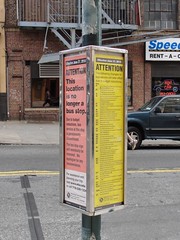 When the MTA issues a fare hike proposal, they usually do so with little to no transparency. The numbers are presented to the public generally as an across-the-board hike put forth to raise revenue by a certain percentage. When the fares went up in 2009, that’s exactly how it played out, and the MTA reached its target of a 7.5-percent revenue increase through a straightforward set of higher fares and a lesser pay-per-ride discount.
When the MTA issues a fare hike proposal, they usually do so with little to no transparency. The numbers are presented to the public generally as an across-the-board hike put forth to raise revenue by a certain percentage. When the fares went up in 2009, that’s exactly how it played out, and the MTA reached its target of a 7.5-percent revenue increase through a straightforward set of higher fares and a lesser pay-per-ride discount.
This time around, the fare hike proposals are more complicated. The MTA has issued two separate proposals, and each, in addition to including higher rates, has its drawbacks. In one plan, riders would be paying over $100 per month for a 30-day Unlimited ride card. In the other, the 30-day card would no longer be unlimited. Instead, for $99 the card would be capped at 90 rides or three swipes per day.
With these two proposals on hand, many have wondered how the MTA arrived at these two proposals. This week, in a letter, Jay Walder explained his thinking. Generally, he says, the authority is looking for ways to keep the fare increases lower for those lower-income riders while raising the rates for those who can afford to pay. Walder notes that “the median household income for people who buy monthly passes is nearly 75% higher than the median household income for people who pay the base fare of $2.25 [with the pay-per-ride discount] or purchase weekly passes. At the same time, the current fare discounts for the monthly pass users with the highest median income far exceed the discounts offered for the fare products used by lower-income riders.”
To put this in context, the MTA CEO and Chairman offered up some numbers. The average 30-day card user has a household income of $63,000, and if he or she uses the current card 90 times a month — which only seven percent of all 30-day card owners do — the cost per ride is $0.99, a full 56 percent lower than the base fare. If a seven-day card user takes 22 rides — the proposed cap for that card — right now, the price per ride is $1.23. People who can afford to pay more and buy in bulk for a longer period of time benefit under the current scheme, and Walder would prefer to raise those fares to a greater extent.
Under the capped proposal, the fares would begin to reach parity, but those who pay for 30-day cards would still benefit. A seven-day card with a 22-ride cap for $28 would lead to costs per ride as low as $1.27 while a 30-day card with a 90-ride cap for $99 could bottom out at $1.10 per swipe with the uncapped $104 card would offer $1.16 per ride on 90 rides.
With this socioeconomic justification for raising the upper echelons of the time-limited MetroCards more so than the lower, Walder also explains why he is proposing capping rides when no other transit agency does so. Since, he says, only seven percent of 30-day card users exceed 90 rides, the rest of us are subsidizing those riders. A cap would allow the MTA to price the cards $5 lower, and thus, he says, the 93 percent of riders who never reach the cap would save $60 per year.
The final piece of this equation in the debate over a capped vs. a true unlimited card is the impact a capped card would have on ridership. The MTA estimates that the decline in ridership would be negligible as the city’s improving economy will bolster transit ridership anyway, and Walder offers his take on the psychology of a capped card. He believes that if the cap is instituted and “the turnstiles are modified to indicate the number of trips remaining (the exact design is being developed), customers will be more aware of the number of trips they are taking and therefore make informed choices that meet their needs.”
I don’t know if informed choices is the right conclusion to draw here or if we should assume that people would be less willing to use the subway earlier in the 30-day period. If I’m granted a limited number of swipes, will I save them for the latter part of the month to make sure I don’t need to buy a new card before the 30 days are up? Will I simply use all 90 and then purchase another card when I need do? Will a counter telling me how much I’ve used or how much I have left discourage frequent ridership or simply redistribute when we ride based upon how many days and rides are left on my MetroCard? Those are questions I — and seemingly the MTA — can’t answer right now.
So for now, these are the ideas behind the MTA’s proposals. The Board won’t make a decision on which hike to endorse until the public comment period is over, and so we the riding public can still influence the debate. The hike may be a foregone conclusion, but what shape it takes will depend on how we want to ride.




